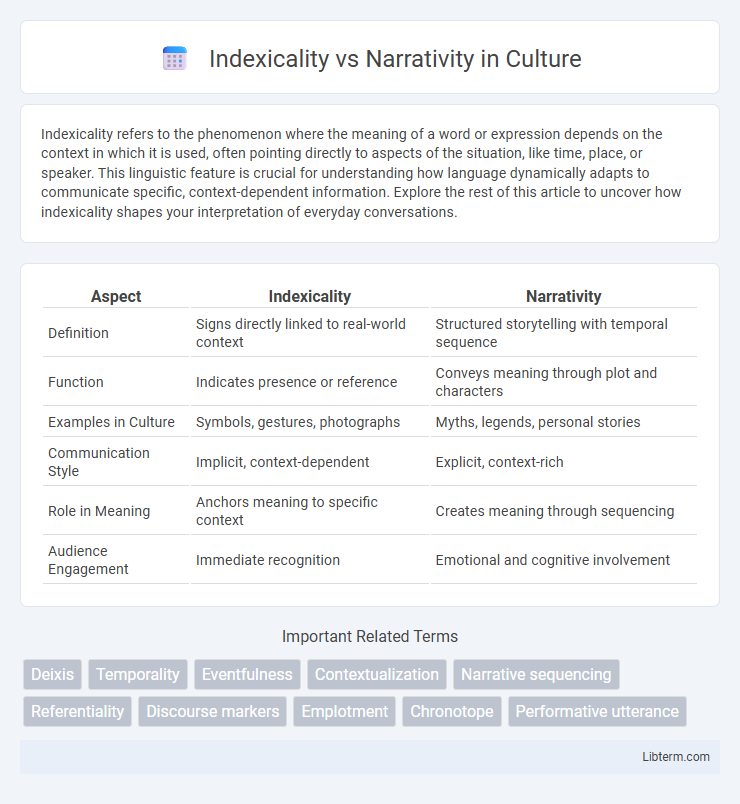Indexicality refers to the phenomenon where the meaning of a word or expression depends on the context in which it is used, often pointing directly to aspects of the situation, like time, place, or speaker. This linguistic feature is crucial for understanding how language dynamically adapts to communicate specific, context-dependent information. Explore the rest of this article to uncover how indexicality shapes your interpretation of everyday conversations.
Table of Comparison
| Aspect | Indexicality | Narrativity |
|---|---|---|
| Definition | Signs directly linked to real-world context | Structured storytelling with temporal sequence |
| Function | Indicates presence or reference | Conveys meaning through plot and characters |
| Examples in Culture | Symbols, gestures, photographs | Myths, legends, personal stories |
| Communication Style | Implicit, context-dependent | Explicit, context-rich |
| Role in Meaning | Anchors meaning to specific context | Creates meaning through sequencing |
| Audience Engagement | Immediate recognition | Emotional and cognitive involvement |
Understanding Indexicality: A Foundational Overview
Indexicality refers to the linguistic phenomenon where expressions directly point to contextual elements such as time, place, or speaker identity, making meaning context-dependent. This foundational concept is crucial for parsing how language anchors utterances within specific situations, distinguishing it sharply from narrativity, which organizes events into a structured, coherent story. Understanding indexicality involves recognizing how deixis operates within communication to establish immediate reference, enabling dynamic interaction beyond static semantic content.
Defining Narrativity: Concepts and Importance
Narrativity refers to the structured representation of events and experiences through a coherent sequence, enabling meaning-making in communication and storytelling. It plays a crucial role in organizing human understanding by linking temporal and causal relationships within a narrative framework. This concept underpins cognitive processes, cultural expression, and interdisciplinary studies in linguistics, psychology, and literary theory.
Indexicality in Language and Communication
Indexicality in language refers to words and expressions whose meaning depends on the context of use, such as pronouns, demonstratives, and temporal adverbs that directly point to participants, time, or place in communication. This semantic feature enables speakers to anchor utterances to specific situational parameters, enhancing clarity and relevance in interaction. Understanding indexicality is crucial for analyzing how meaning is dynamically constructed and interpreted within conversational exchanges.
The Role of Narrativity in Meaning-Making
Narrativity plays a crucial role in meaning-making by structuring experiences into coherent sequences that facilitate understanding and interpretation. It links disparate events through causal and temporal relations, enhancing cognitive engagement and emotional resonance. This narrative framework contrasts with indexicality, which anchors meaning in immediate context and direct reference, highlighting how narrativity extends meaning beyond presence to encompass broader human experience.
Comparative Analysis: Indexicality vs Narrativity
Indexicality refers to linguistic or semiotic elements that point directly to contextual features, anchoring meaning to specific times, places, or agents, whereas narrativity emphasizes the structured representation of events in a temporal sequence to convey a coherent story. Comparative analysis reveals that indexicality grounds communication in immediate context and situational cues, while narrativity constructs broader interpretative frameworks by organizing actions and experiences into meaningful plots. Understanding their interplay offers critical insights into how meaning is dynamically constructed through both signifiers linked to context and narrative structures that shape human experience over time.
Indexicality in Visual and Media Studies
Indexicality in visual and media studies refers to the direct, tangible connection between a sign and its referent, often highlighting the presence of a physical trace such as a photograph's imprint of light or a fingerprint's unique pattern. This concept emphasizes the authenticity and evidential power of images and media as indexes, grounding meaning in real-world referents rather than abstract representation. The study of indexicality addresses how visual media capture and convey reality through these inherent traces, distinguishing them from purely narrative constructions that prioritize storytelling and subjective interpretation.
Narrativity across Different Textual Genres
Narrativity across different textual genres shapes how stories are structured and experienced, influencing coherence and engagement through plot development, character arcs, and temporal sequencing. Genres such as novels, films, and oral traditions utilize distinct narrative techniques to convey meaning, evoke emotion, and construct identity, thereby enhancing the interpretative frameworks available to audiences. The variation in narrativity reflects the diverse cultural functions and communicative purposes embedded within each genre, highlighting its role in meaning-making beyond mere indexical references.
Cognitive Implications of Indexicality and Narrativity
Indexicality involves situational references that require real-time contextual understanding, engaging the brain's working memory and attentional systems actively. Narrativity, by structuring information into coherent sequences, helps with memory consolidation and interpretative processes through familiar cognitive schemas. Together, these elements shape how individuals process and make sense of information, influencing comprehension and retention.
Practical Applications: From Theory to Practice
Indexicality informs practical applications in linguistics, enabling precise context-dependent meaning interpretation crucial for effective communication in AI systems and discourse analysis. Narrativity provides structured frameworks for storytelling in education and marketing, enhancing engagement and memory retention through coherent temporal sequences. Integrating indexicality and narrativity supports human-computer interaction design by improving contextual responsiveness and user experience in digital platforms.
Future Directions in Indexicality and Narrativity Research
Future directions in indexicality and narrativity research emphasize integrating multimodal communication to better understand how context shapes meaning across diverse media. Advances in computational linguistics offer promising tools to analyze narrative structures and indexical cues simultaneously, enhancing the precision of discourse analysis. Emerging studies aim to explore the interplay between indexical references and narrative coherence in digital narratives, virtual reality, and social media platforms.
Indexicality Infographic

 libterm.com
libterm.com